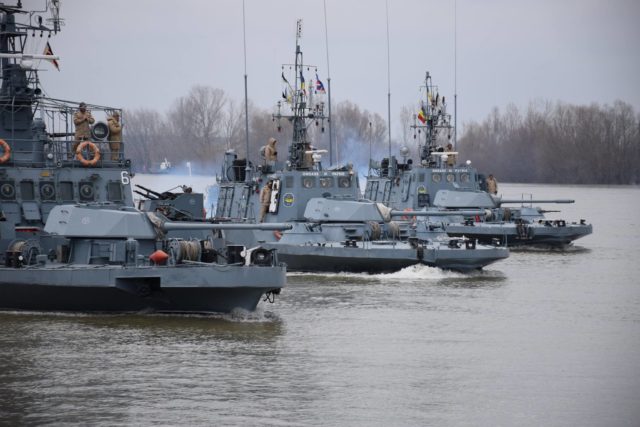
Romania’s Danube Flotilla: An Unparalleled Capability on NATO’s Southeastern Flank (Part One)
Publication: Eurasia Daily Monitor Volume: 17 Issue: 45
By:

The Danube is the second-longest river in Europe and one of its main transport and communication routes. In terms of economic value, only the Rhine River is more important for the overall European economy. This fact is underscored by the building of the Rhine–Main–Danube canal, which opened in 1992. The almost-thirty-year-old canal physically links Europe from west to east, allowing for the shipment of cargo and people using an inland waterway route linking Constanța, on the Black Sea, with Rotterdam, on the North Sea.
Romania is a “Danubian” country both geographically and politically. Before the appearance of the modern Romanian state in 1859, the principalities of Moldavia and Wallachia were known in Western chanceries as the “Danubian Principalities.” Romania’s security and defense is intrinsically linked with the river—control of the Danube as well as operations along its course featured prominently in all the wars fought by Romania since its establishment as a modern nation-state in 1859 (the Russo-Turkish War of 1877–1878, the 1913 Second Balkan War, World War I and World War II).
Control of the river was one of the main drivers that led to the creation of the modern Romanian Navy. The first Romanian military vessels were river patrol craft that enforced the new state’s interests and sovereignty on the Danube. The origins of the Romanian Naval Forces, thus, lie squarely with the small ships that made up the riverine flotilla in the 19th century.
Today, the fleet of the Romanian Naval Forces is divided into two main commands: the Riverine Flotilla Command and the Fleet Command. The Riverine Flotilla Command has an area of responsibility that includes the Danube River, the Danube Delta, and the mouths of the Danube. The main missions of the Riverine Flotilla are: deterrence against aggression, surveillance, intelligence-gathering concerning river traffic, and protection of the riverine communication routes and ports (Navy.ro, accessed April 2). In tactical terms, these missions translate into combating enemy surface ships, joint operations with other branches, preventing enemy forces from crossing the Danube, providing naval gunfire support for the ground forces during operations along the river, transport and naval gunfire support for amphibious operations, and convoy escort.
The ability of the Romanian armed forces to control and interdict the use of the river to any potential adversary is paramount for the country’s defense and security. In all the conflicts that the modern Romanian state has been involved, the ability of its armed forces to cross the Danube at a place of their own choosing has been crucial for any successful military operation. Control over the river allows for increased maneuverability both in defense as well as offense by giving the Romanian Armed Forces the ability to launch operations at any points along the river and seize the initiative.
In order to cross the Danube during crises or wartime, the Romanian Armed Forces plan to mount a joint operation in which Land Forces, Naval Forces and the Air Force will have to work together. Army engineers will be responsible for installing a pontoon bridge. The River Crossings Battalion of the 10th Engineers Brigade will support the bridgehead with its ferries and specialized riverine craft by carrying additional troops and materiel. Meanwhile, riverine flotilla ships will protect and support the engineers building the pontoon bridge and the troops establishing the bridgehead. This type of joint operation was showcased during the North Atlantic Treaty Organization’s (NATO) Saber Guardian 2017 exercise (Hotnews.ro, July 17, 2017) and garnered praise from Lieutenant General Ben Hodges (now retired), then commander of the United States Army in Europe (YouTube, July 21, 2017).
The Danube Flotilla is made up of four main units: the 67th Artillery Carrying Ships Squadron, 88th Patrol Boat Squadron, the 131st Logistic Support Ships Squadron and the 307th Marine Infantry Regiment. The main strike force is the artillery-carrying ships squadron, which is equipped with three monitor and four armored gunboats. The larger ships are supplemented and aided by a patrol boat squadron composed of 12 boats equipped for minesweeping. The 131st Logistic Support Squadron provides support, while the 307th Marine Infantry Regiment is tasked with protecting the Danube Delta and carrying out amphibious operations along the river.
At present, the Danube Flotilla is the strongest riverine unit of its kind in Europe and makes Romania the primary naval power on the Danube River. The monitors and armored gunboats are the largest and the most heavily armed ships of their kind operational with any modern navy. The design of these ships was inspired by the Soviet Navy’s monitors and armored gunboats used on the Amur River as well as by the monitors used by the Romanian Navy in both world wars. Each monitor comes equipped with two 100-millimeter cannons in two modified tank turrets placed forward and aft, two 122-millimeter Grad-type multiple-launch rocket systems (MLRS) as well as various light anti-aircraft guns (Roec.biz, March 14, 2017). The patrol gunboats have just one forward-facing 100-millimeter tank turret, two 122-millimeter rocket launchers, and light anti-aircraft artillery. Romania’s immediate neighbors Hungary, Serbia, Ukraine and Bulgaria do not wield anything similar to the capabilities of the Danube Flotilla, although Kyiv and Belgrade operate small, armed riverine patrol craft.



